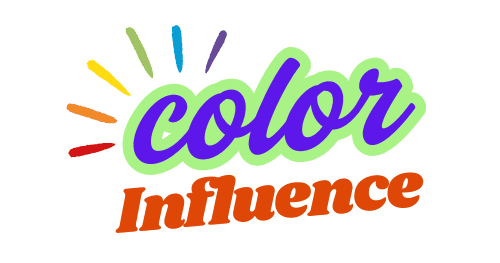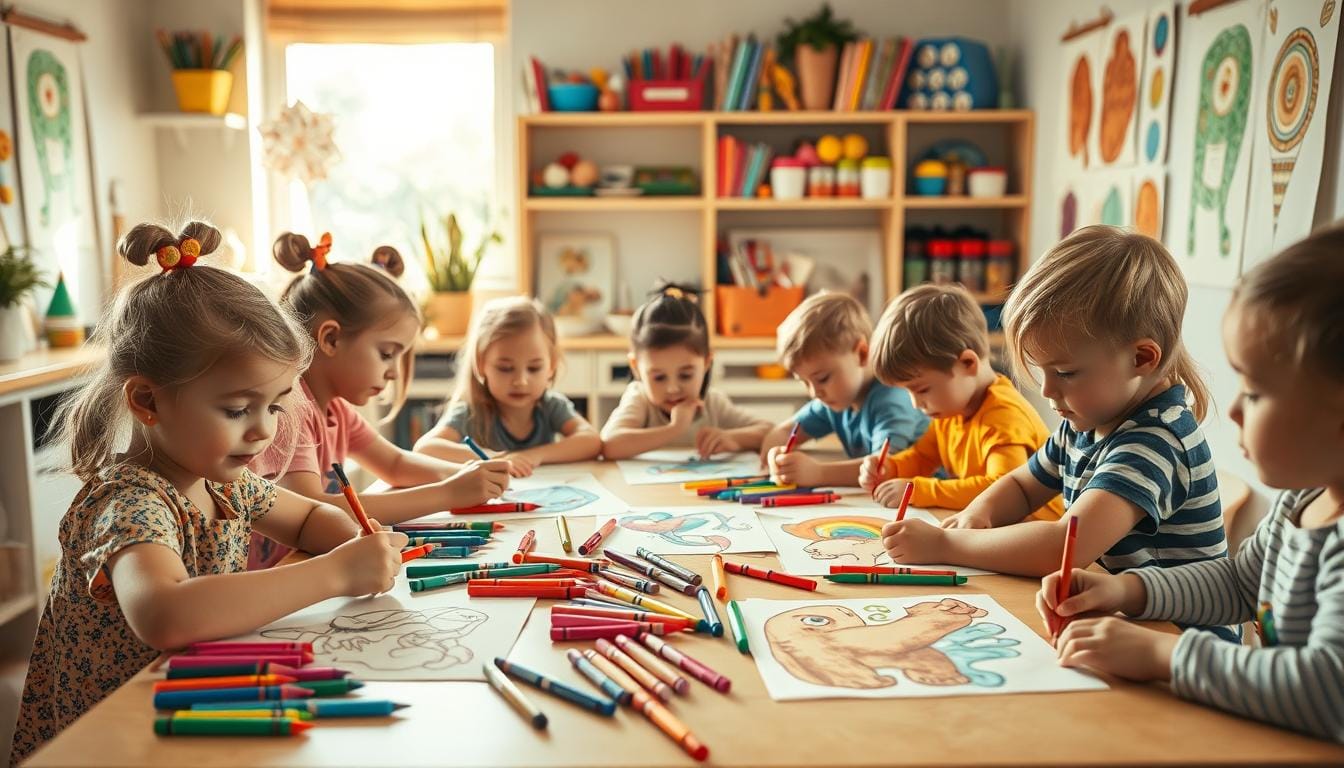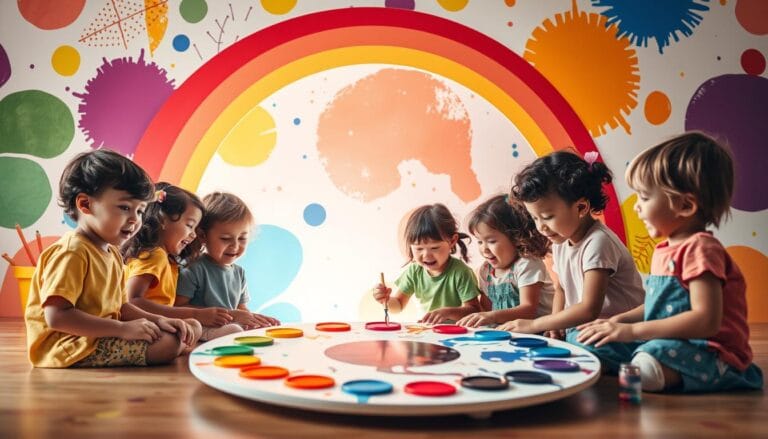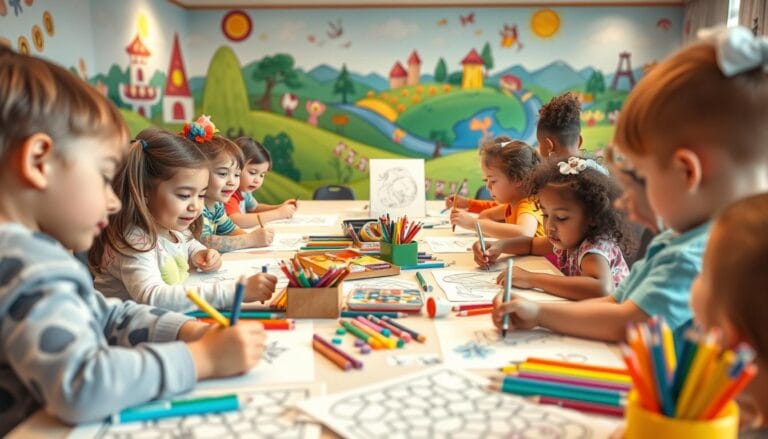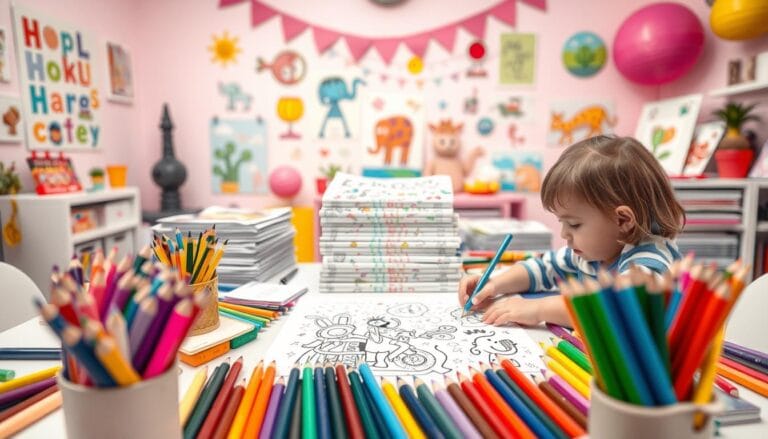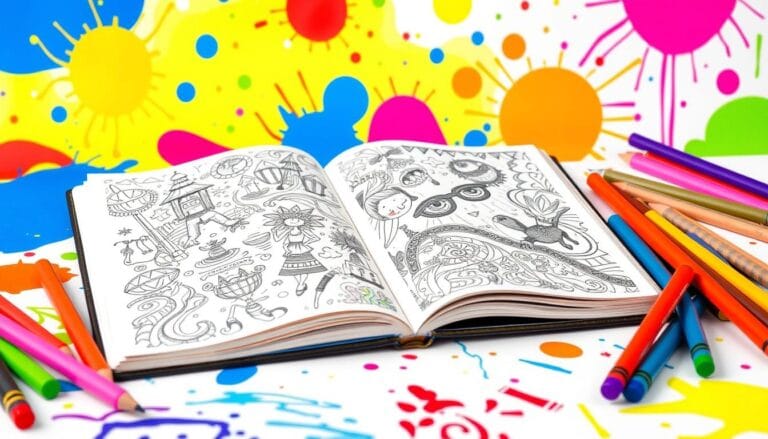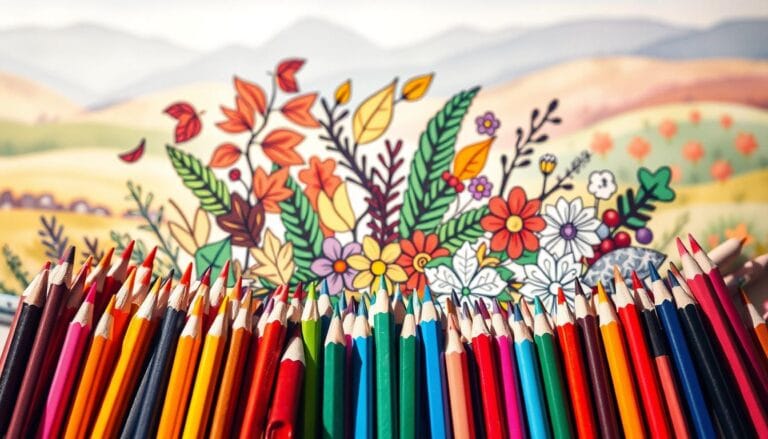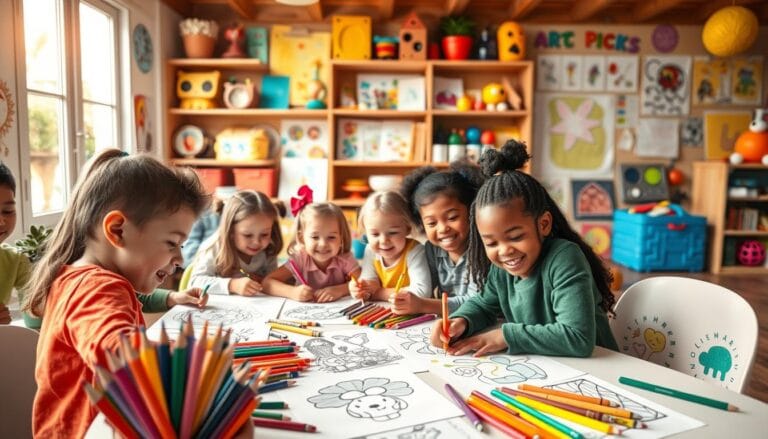Trending Coloring Ideas for Kids: From Simple Sketches to Masterpieces
Do you remember the joy of coloring? It’s more than just an activity. It opens up a world of imagination for kids. In today’s world, coloring is a way for kids to express themselves creatively and learn new things.
SSColoring offers a vast world of coloring pages. They turn simple moments into exciting adventures. Kids can explore their creativity with themes like mythical creatures and space explorers.
Coloring is not just fun. It’s also important for kids’ development. It helps improve their fine motor skills, hand-eye coordination, and patience. Each time they color, they learn something new and express themselves in a special way.
Understanding the Creative Journey of Young Artists
Art lets kids explore their feelings and express emotions in ways words can’t. The creative journey of young artists is a journey of self-discovery. It’s more than just coloring.
“The urge to draw must be quite deep within us, because children love to do it.” – David Hockney
The Psychology Behind Children’s Art Expression
Art shows us how kids see and interact with the world. Process art lets kids:
- Explore their feelings freely
- Think critically
- Solve problems
- Feel confident through art
Benefits of Regular Coloring Activities
Doing art helps kids in many ways. It:
- Improves fine motor skills
- Helps recognize colors
- Helps process emotions
- Makes thinking more flexible
Age-Appropriate Coloring Techniques
Each age needs its own way of creating art. For kids aged 5-12, art is key for growing emotionally. It helps them understand themselves better through art.
Parents can help by giving kids different art supplies. This encourages them to explore and grow emotionally.
Essential Art Supplies for Kid’s Coloring Adventures
Starting on creative arts and crafts adventures needs the right tools for young artists. Choosing the right educational toys and art supplies makes coloring fun and educational. It’s all about picking safe, age-right materials that spark imagination and creativity.
For toddlers and young children, here are essential art supplies to kickstart their creative exploration:
- Crayola Washable Fingerpaint for mess-free creativity
- Jumbo Crayons designed for small hands
- Washable Markers with non-permanent staining
- Safety scissors (recommended for ages 2-3)
- No-spill paint cups to prevent unexpected messes
Keeping things organized is key for an art-friendly space. Clear, labeled containers make it easy for kids to find and put away their supplies. An art smock keeps clothes clean during messy times. A toddler-sized easel encourages kids to express their art.
Try out new art supplies like Stabilo Woody 3-in-1 pencils. They work as window art, watercolor paints, and colored pencils. Crayola’s Education Watercolor Set gives kids bright colors to play with. Air-dry modeling materials like Crayola air-dry clay let kids sculpt without making a mess.
Using recycled materials like cardboard boxes and paper towel rolls is good for the planet. Colored tissue paper is great for suncatchers, collage, and papier-mache. It adds an eco-friendly twist to art projects.
Creativity knows no bounds when you have the right tools and imagination!
Trending Coloring Ideas for Kids
Let your child’s creativity shine with the latest coloring trends. These ideas turn simple drawings into colorful masterpieces. Kids will have fun learning new coloring techniques that boost their imagination and artistic skills.
Coloring has changed a lot, offering kids new ways to express themselves through art. Today’s coloring trends are fun and educational, making learning a joy for kids.
Popular Character-Based Coloring Projects
Kids adore coloring their favorite characters. There are many coloring books filled with their beloved characters:
- Disney character collections with over 100 unique designs
- Superhero-themed pages featuring popular characters like Iron Man and Batman
- Cartoon favorites including Pikachu, Minions, and SpongeBob
Nature-Inspired Coloring Activities
Nature is a great source of inspiration for kids. They can explore the natural world through coloring activities like:
- Animal-themed pages with 10 different wildlife illustrations
- Sea creature designs featuring marine life
- Landscape and ecosystem representations
Abstract and Geometric Patterns
For older kids, there are now complex geometric and abstract designs. These challenge their spatial awareness and creativity.
| Coloring Book Type | Age Range | Number of Pages |
|---|---|---|
| Character Coloring Book | 4-12 years | 100+ pages |
| Nature-Themed Book | 3-8 years | 50-90 pages |
| Abstract Pattern Book | 6-13 years | 20-40 pages |
“Coloring is a powerful way for children to explore their creativity and develop essential motor skills.” – Art Education Expert
Parents can help their kids grow artistically by offering a variety of coloring resources. This makes learning fun and engaging.
Interactive Coloring Techniques
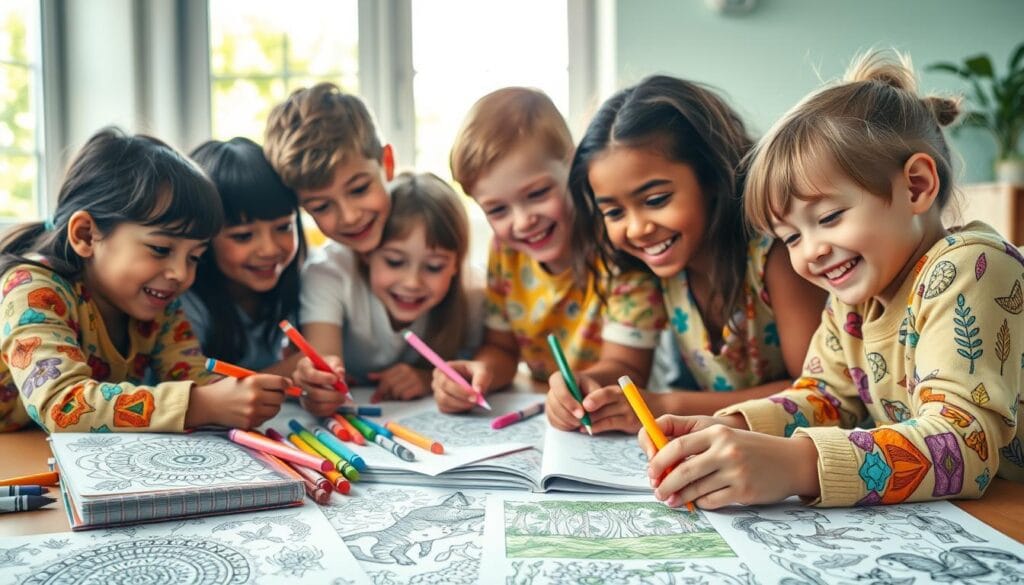
Interactive coloring techniques turn kids activities into fun adventures. Young artists enjoy finding new ways to add color to their world. They turn simple drawings into bright, beautiful works of art.
Here are some fun coloring methods to spark your child’s imagination:
- Bubble Painting: Mix paint with dish soap and blow bubbles onto paper for magical circular designs
- Ice Painting: Freeze colored water in trays and use ice cubes as unique painting tools
- Splatter Painting: Create dynamic artwork by flicking paint across the canvas
- Fizzy Paint Moon Craft: Combine baking soda and paint for an exciting textured effect
- Pineapple Finger Painting: Use hand prints to create fun tropical scenes
These methods make coloring not just fun but also educational. Kids get better at hand-eye coordination, exploring their senses, and fine motor skills. They also get to show off their creativity. Always watch over young artists and pick materials that are safe and right for their age.
The secret to great kids activities is to keep them fun and stress-free. Let your child try new things, make mistakes, and have fun making something special just for them.
Digital vs Traditional Coloring Methods
The world of coloring has changed a lot, offering kids new ways to be creative. Now, they can use digital and traditional methods to express themselves. This is thanks to new technology that lets them explore coloring pages and educational toys.
Benefits of Digital Coloring Tools
Digital coloring tools have changed how kids create art. Studies show 60% of children’s book illustrators prefer digital tools. These tools offer great benefits:
- Unlimited color palette options
- Easy mistake correction
- Interactive learning experiences
- Access to diverse drawing brushes
Traditional Coloring Materials and Their Charm
Traditional coloring materials still have a special place in kids’ art. Holding crayons, colored pencils, and markers gives a unique feeling. This feeling is something digital tools can’t match.
| Traditional Materials | Unique Benefits |
|---|---|
| Colored Pencils | Precise control and texture |
| Watercolor Paints | Blending and gradient effects |
| Crayons | Vibrant colors and easy grip |
Finding the Right Balance
Finding a balance between digital and traditional coloring is key. Toys that mix both can help kids learn art well. Encourage your child to try different ways, making coloring fun and educational.
By using both digital and traditional coloring, kids can explore their creativity fully. They get to enjoy a rich and varied artistic journey.
Educational Benefits Through Creative Coloring
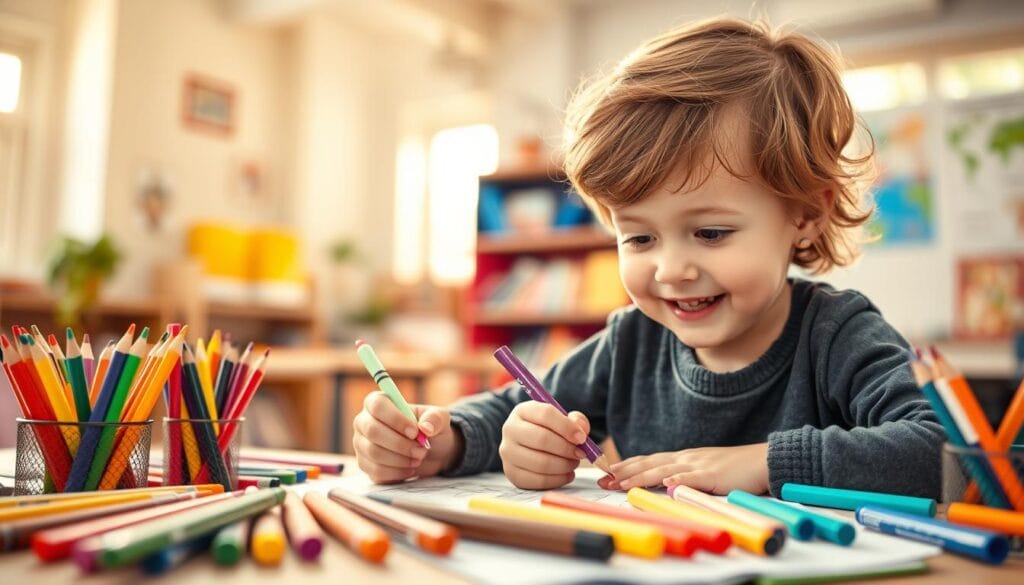
Coloring is more than just a fun activity for kids. It’s a powerful tool for learning that offers amazing benefits. Studies show that coloring can boost a child’s thinking and motor skills, making learning fun.
Parents can use coloring as a smart way to teach. Kids who color regularly focus better and think clearer. In fact, 70% of them pay more attention after coloring often.
- Enhances fine motor skill development
- Boosts creativity and problem-solving skills
- Improves hand-eye coordination
- Serves as an emotional expression outlet
For the best learning, pick coloring projects that match your child’s age. Using interactive coloring techniques makes learning exciting.
| Coloring Benefit | Educational Impact |
|---|---|
| Fine Motor Skills | Prepares for writing and crafts |
| Creativity | 15% higher creativity assessment scores |
| Emotional Expression | 60% of children feel more relaxed |
Adding coloring to learning makes it fun and engaging. It supports your child’s growth in all areas. Art is more than making pretty pictures. It’s about growing young minds and exploring new ideas.
Advanced Coloring Projects for Developing Artists
As kids grow, they want more challenging and fun projects. Advanced coloring lets them dive deeper into learning and creativity.
Mixed Media Coloring Experiments
Trying new things in coloring opens up a world of possibilities. Kids can mix different materials to make their own unique art:
- Watercolor and crayon resist techniques
- Combining colored pencils with markers
- Integrating collage elements with coloring
- Using unconventional tools like cotton swabs or sponges
Storytelling Through Colors
Colors are a powerful way for kids to tell stories and share feelings. Encourage your child to create visual stories by picking colors that match their emotions or characters.
| Color | Emotional Representation | Storytelling Potential |
|---|---|---|
| Red | Passion, Energy | Heroic Characters |
| Blue | Calm, Serenity | Peaceful Scenes |
| Green | Growth, Nature | Adventure Settings |
Cultural Art Exploration
Introduce your child to art from around the world through coloring. They can learn about different cultures and grow their creativity.
- Native American sand painting techniques
- Japanese watercolor styles
- African geometric pattern coloring
- Indigenous textile design inspiration
These projects turn coloring into a deep, educational journey. They boost imagination and cultural understanding.
Safety and Best Practices in Children’s Art
Choosing the right materials is key for safe and fun art projects with kids. Use non-toxic supplies, especially for young artists. Water-based resins and finger paints are safer than chemical-based ones.
For art safety, set up a dedicated space with protective coverings. Use tools that fit your child’s age and watch them closely. Pick materials made for kids, avoiding harmful substances.
Getting ready for art is important. Dress kids in easy-to-clean clothes or smocks. Have a clean surface and cleaning supplies ready. Making your own finger paints is a safe and fun way to explore art.
Art should be fun and educational. Praise your child’s work and show it off. Create a positive space for them to keep exploring and creating.
FAQ
At what age should I start introducing coloring activities to my child?
You can start with coloring at 18 months to 2 years old. Use big crayons and large coloring pages. It’s all about fun and exploration, not perfect coloring.
What are the best art supplies for young children?
Choose non-toxic, washable supplies like thick crayons and large pencils. Crayola has safe, easy-to-use options. Make sure they’re big enough for little hands to hold.
How can coloring help my child’s development?
Coloring boosts fine motor skills, hand-eye coordination, and creativity. It teaches about boundaries and helps with concentration. It also improves pencil grip and gets kids ready for writing.
Are digital coloring apps good for children?
Digital coloring is good in small doses. Choose apps that teach and encourage creativity. But, mix it with real coloring to keep hands busy and screen time low.
How can I make coloring more engaging for my child?
Try themed coloring and art together. Use watercolors, chalk, and textured papers. Add stories to make it more fun and meaningful.
What safety precautions should I take during art activities?
Always watch over kids during art. Use safe materials and cover surfaces. Dress them in smocks and teach them about safe art handling.
How can I encourage my child’s artistic expression?
Praise their effort, not just their work. Show their art and ask about their process. Offer many materials to keep them interested and creative.
Can coloring help children learn academic skills?
Yes, it can! Color-by-number helps with math. Themed pages teach science. Art stories boost language and thinking.
